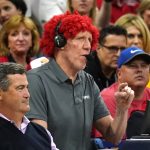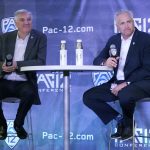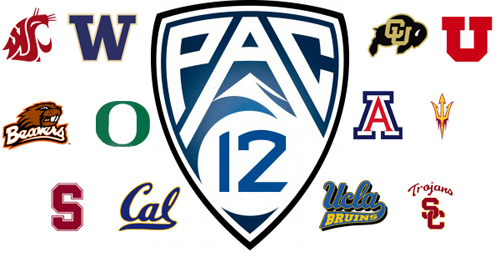The Hotline mailbag is published each Friday. Send questions to pac12hotline@bayareanewsgroup.com or hit me on Twitter: @WilnerHotline. Due to volume — and in some cases, the need for research — not all questions will be answered the week of submission. Thanks for your understanding.
Some questions have been edited for clarity and brevity.
Why does the Pac-12 compete better in basketball relative to football? Is it just a few key coaches keeping the talent home? — @jkparker2000
Some would argue the conference doesn’t compete any better in basketball than football given the span of time since the last national championships (18 years for football, 25 for basketball).
But with Oregon in the Final Four in ’17, UCLA making its run in ’21, the overall tournament success last spring, plus the current poll placement of Arizona and the L.A. schools, there’s clearly a case to be made for the conference experiencing more relative success on the court than on the field.
Why? Smart coaching hires, resource investment, conference management and other factors are assuredly part of the calculation.
But in our opinion, the root cause of the difference can be found in population demographics and the requirements of the sports:
You need big bodies to win football championships, and there aren’t as many of those in the Pac-12 footprint compared to other regions of the country.
What do I mean by that?
College basketball is a perimeter game. Stock the roster with a few top talents who are 6-foot-5 and 200 pounds, and you can compete for championships.
But college football, for all the fancy-pants formations and no-huddle offenses, is still won on the line of scrimmage. You need blue-chip talents who are 6-foot-5 and 300 pounds — and lots of them — to compete with the best of the Big Ten and SEC.
The Pac-12 footprint has more than enough basketball bodies, relative to other regions, to produce high-level success. UCLA is a perfect example: Johnny Juzang and Jaime Jaquez Jr. are Southern California natives who carried the Bruins to the Final Four on their 220-pound backs.
But the footprint is sorely lacking in blue chip-level 300 pounders. There aren’t as many of them across the country in general, but especially on the West Coast.
Why might that be? A few reasons come immediately to mind:
1. Concerns over head trauma have prompted many parents to steer their sons to other sports; some would have the potential to mature into line-of-scrimmage body types if they spent enough time in the weight room. (The Hotline has documented this issue.)
2. Too much kale on the dinner plates, not enough potatoes. (I am only half-joking about that.)
3. The high percentage of Latino and Asian American populations within the Pac-12 footprint compared to other regions: Football simply isn’t as prominent in their sporting cultures.
4. Above all, the lower degree of passion for football in the West, which impacts all three explanations listed above.
The Pac-12 footprint produces plenty of skill-position talent, where the body types are comparable to what’s required for basketball success: 6-foot-5, 200-pounders (or smaller).
But the lack of blue chip linemen on this side of the Rockies, compared to the talent pipelines in the SEC and Big Ten states, is an existential threat to Pac-12 football.
Any Pac-12 additions in the works? Gonzaga for basketball? BYU? San Diego State? — @round_mound34
Any chance the Pac-12 will reconsider expansion to 14 teams with Houston and TCU if the network partners want it in the next deal? — @DouglasTS
It’s all quiet on all expansion fronts … for now.
The next window for change will come in 12-15 months, during the Pac-12’s media rights negotiations. If potential partners (Fox, ESPN, CBS) indicate membership expansion would be worthwhile, the conference will undoubtedly explore.
But remember, any new members must carry enough media value to increase the revenue share for the existing schools. It’s not enough to increase the size of the revenue pie; the individual slices must get bigger, too. We’re skeptical — deeply skeptical — of that outcome.
If expansion materializes, football would be the driving force: It accounts for 85 or 90 cents of every media dollar spent on college sports.
There’s no reason for the Pac-12 to add Gonzaga; Brigham Young found a home in the Big 12; and the Pac-12 media market area covers San Diego County.
From our vantage point, the only place to plant the Pac-14 flag is Texas, perhaps on TCU’s campus but certainly on Houston’s — if the conference determines the schools would bring enough value.
What are the chances? In our opinion, only 10 percent at this point. But there are enough external forces (CFP expansion, NIL, media market trends) to create a fluid situation.
Is there any realistic chance Arizona can pass Gonzaga for the No. 1 seed in the West regional? —@ElGatoRojoAzul
I wouldn’t call it likely, but it’s certainly plausible that Arizona earns the coveted No. 1, which would create a path to the Final Four through the regional in San Francisco.
At the moment, the Zags are No. 1 in the NET rankings, with Arizona No. 2. They have an advantage over the Wildcats in the Pomeroy efficiency ratings and own one more Quadrant I victory.
But if the Wildcats win out — a process that would carry multiple Quad I wins — they could very well overtake the Zags.
And if the Wildcats win out and Gonzaga loses, I would expect them to receive the San Francisco placement.
Arizona fans should expect to start the NCAAs in San Diego and play the second weekend in either San Antonio, Chicago or San Francisco (at the Chase Center, the Warriors’ new home). It would all depend on the other No. 1 seeds, given the emphasis the selection committee places on proximity to campus.
There’s also the potential for a few losses to result in Arizona receiving a No. 2 seed and being bracketed with the Zags at the Chase Center. But that seems the less likely outcome.
With all the Lincoln Riley hype and the recruiting boost, is success a foregone conclusion — and if not, how much patience is there for an inevitable letdown if they don’t light the world on fire. — @rob0752
This issue depends entirely on the timeline for, and definition of, success.
If the Trojans win nine or 10 games next season but don’t make the playoff, the blowback will be limited.
Despite the hype over USC’s roster and Riley’s work in the transfer portal, USC doesn’t have a playoff-caliber defense. (We’re not sold on the offensive line, either.)
Our view: It’s reasonable to expect a playoff berth in the 2023 season — and certainly by 2024.
I mean, the Trojans aren’t paying him $10 million a year (approximately) to remain on the CFP sideline for more than a couple years.
And Riley didn’t take the job with that expectation, either.
Am I wrong to think ASU president Michael Crow is waiting for the NCAA’s next move before cleaning house so he can fire athletic director Ray Anderson and coach Herm Edwards with cause and save millions of dollars? Also, is there any chance he calls his old pal Larry Scott to be the next AD (please say no)? — @Esdee1467
That’s a logical conclusion, but guessing along with Crow is a perilous endeavor.
Edwards’ contract runs through the 2024 season at approximately $4 million annually, while Anderson’s deal has four more years and a salary that approaches $1 million annually.
But Crow has never struck the Hotline as a president concerned about athletic expenses, at least compared to his peers across the conference. (More than any other president, Crow enabled Scott’s free-spending ways at HQ.)
As for the Scott piece, the answer is no … no, no, NO!
First, he isn’t qualified to run an athletic department, which requires a different skillset from the commissioner role.
Also, he has no motivation.
Thanks largely to the contract that Crow negotiated on behalf of the conference, Scott took home about $50 million over his 12-year tenure.
What has gone wrong with Oregon basketball this year? Lots of talent, terrible execution. — @TheRealeJMoney
Two recent results were jaw-dropping, particularly in their lopsided nature: The Ducks lost to Cal by 14 and to ASU by 24.
Their current NET ranking, No. 71, suggests an extraordinarily narrow path into the NCAA at-large field. If they don’t win the Pac-12 tournament, the Ducks probably will miss the NCAAs for just the second time in the past decade.
Coach Dana Altman’s entire approach to team building is high-risk, high-reward: He’s unafraid to overhaul the roster each year and place an outsized reliance on transfers.
Typically, he makes it work — no one is better at the assimilation process — and the Ducks coalesce in time for the postseason.
But performing meatball surgery year after year will invariably result in losing a patient once in a while.
This season, the mix of players just isn’t working, despite how it appeared just a few weeks ago.
The offense is erratic, the defense hasn’t meshed, and the body language doesn’t look good. The chemistry seems all wrong.
What are the options for USC when Andy Enfield leaves for the Maryland job? Personally, I will celebrate when he’s finally gone. He’s a terrible in-game coach who gets clowned every time he matches up against a quality coach. — @ObiWanKobe
There is a decent chance Enfield, who grew up in Pennsylvania and went to college in Maryland, leaves for a job on the East Coast this spring. But I’m not sure that’s the most likely end-game.
(His contract reportedly runs through the 2025-26 season and could be extended.)
Nor would I agree that he “gets clowned” by quality coaches. After all, the Trojans have five consecutive wins over UCLA.
However, USC’s administration undoubtedly has a shortlist of candidates. If Colorado State’s Niko Medved and Wyoming’s Jeff Linder aren’t on it, I would be surprised.
Can Washington State basketball be a disappointment this year considering their past decade? P.S.: Still super excited for their future though. — @SirCharles_OG
Only a collapse down the stretch would result in this season being viewed as a disappointment for the Cougars (14-11, 7-7).
They were picked eighth in the Pac-12 preseason media poll; they’re currently in the middle of the pack; and they’re in contention for an opening-round bye in the conference tournament.
This, with a roster that has only one senior (guard Michael Flowers) in the core rotation.
The outlook hasn’t been this bright for WSU since the Tony Bennett era, which only seems like a century ago.
Coach Kyle Smith felt like the right hire at the time (March ’20) and has arguably exceeded expectations.
If we’re being honest, there’s a greater chance that success leads to him getting lured away by another program than the Cougars regress to their former home on the bottom tier of the standings.
Support the Hotline: Receive three months of unlimited access for just 99 cents. Yep, that’s 99 cents for 90 days, with the option to cancel anytime. Details are here, and thanks for your support.
*** Send suggestions, comments and tips (confidentiality guaranteed) to pac12hotline@bayareanewsgroup.com or call 408-920-5716
*** Follow me on Twitter: @WilnerHotline
*** Pac-12 Hotline is not endorsed or sponsored by the Pac-12 Conference, and the views expressed herein do not necessarily reflect the views of the Conference.
Related posts:

(AP Photo/Rick Scuteri)
Wilner Hotline – Bill Walton a Star Attraction at Pac-12 Tournament
(AP Photo/Jeff Chiu)
Wilner Hotline – Key Pac-12 presidents address commissioner George Kliavkoff’s performance on the anniversary of hiring him
(AP Photo/Ralph Freso, File)
Brandon Huffman Pac-12 Recruiting Notebook: USC flips a Cal commit, Utah grabs a linebacker, UW secures in-state prospect, Rashada eliminates the West Coast
Southern California quarterback Caleb Williams (AP Photo/Marcio Jose Sanchez)
Pac-12 need-to-knows: It’s not all about Utah and Oregon, new QBs in the spotlight, eyeballs matter and more
